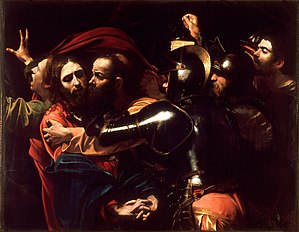
| Events in the |
| Life of Jesus according to the canonical gospels |
|---|
 |
|
Portals: |
The arrest of Jesus was a pivotal event in Christianity recorded in the canonical gospels. It occurred shortly after the Last Supper (during which Jesus gave his final sermon), and immediately after the kiss of Judas, which is traditionally said to have been an act of betrayal since Judas made a deal with the chief Israelite priests to arrest Jesus. The event ultimately led, in the Gospel accounts, to Jesus's crucifixion.[1][2]
The arrest led immediately to his trial before the Sanhedrin, during which they condemned him to death and handed him to Pontius Pilate the following morning.[3] In Christian theology, the events from the Last Supper until the crucifixion and resurrection of Jesus are referred to as the Passion.
In the New Testament, all four Gospels conclude with an extended narrative of Jesus's arrest, trial, crucifixion, burial, and resurrection. In each Gospel, these five events in the life of Jesus are treated with more intense detail than any other portion of that Gospel's narrative. Scholars note that the reader receives an almost hour-by-hour account of what is happening.[4]: p.91
- ^ "Bible Gateway passage: Matthew 26:14-16 - New International Version". Bible Gateway.
- ^ "The death of Jesus", BBC
- ^ "Bible Gateway passage: Mark 15 - New International Version". Bible Gateway.
- ^ Powell, Mark A. Introducing the New Testament. Baker Academic, 2009. ISBN 978-0-8010-2868-7